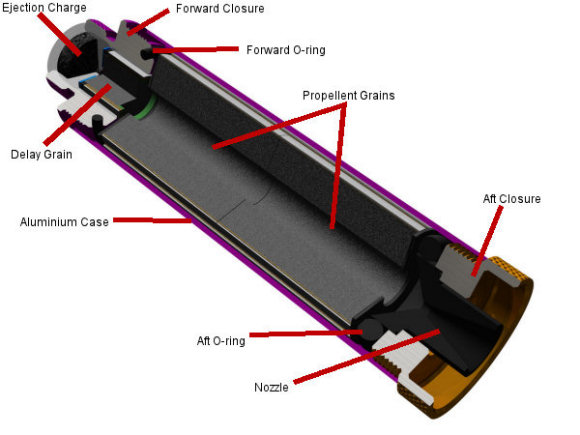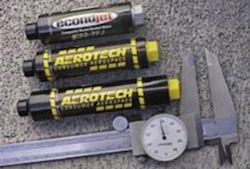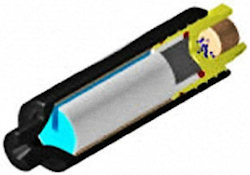If you have a question that you don’t see in any FAQ,
let us know, and we’ll try to answer it and add it to one of the FAQ’s.
When black powder (BP) E’s aren’t big enough anymore, the next move is to composite motors. Commercial composite motors are made of a mix of ammonium perchlorate (AP) (oxidizer) and HTPB (hydroxyl-terminated polybutadiene) rubber (as fuel and binder). This combination (sometimes referred to as APCP) is much more powerful than black powder and amazingly, safer too. It is much harder to light than BP, and if it is not burned under pressure it burns very slowly. This makes these motors the safest available.
Below are the major parts of the motor.

All composite motors come in various average thrusts regulated by several primary characteristics. Surface burning is a very important factor. Composites can be formed, cored or sawn to give a different amount of surface to the flame area during motor firing. These are known as grain patterns. The most common is a BATES (acronym for BAllistic evaluation TESt motor) grain. This is a simple, constant diameter, hole down the center of multiple grains. This gives additional surface area to burn since the face of each grain burns as well as the core. The end result is a flatter thrust curve instead of a constantly increasing curve.
The one exception to the traditional core burning motors is the “C-slot”. These are solid grains with slots cut down one side. They typically provide a much lighter thrust over a longer period of time in relation to a “core burner” due to the restricted surface area for gas production.
The length of the grain is another factor. As composites burn from the inside out, doubling the length and face of each grain roughly doubles the gas producing area. This is analogous to a four vs. eight cylinder engine. More cylinders (i.e. more grains) = more power added. There is a limit to this length versus core diameter, though. As the propellant gas requires an adequately sized exit point. If one is not available in a relatively short distance, and of the proper diameter, the gases will make their own. This is the reason for the metal seal ring in long length 29 and 38 mm reloadable motors, it provides a head end restriction to force the gas back down the core.
| Note that as opposed to BP motors, composite motors are ignited at the top of the fuel grains. This ensures that the delay grain ignites at the same time as the fuel grains. | |
| During the burn all surfaces of the grains are burning. The total area of burning surface staying about the same keeping the thrust level fairly constant. That make this a BATES grain. | |
| Later in the burn the total surface area begins to decrease since the ends of the grains are burning at the same time as the core is burning. This causes the thrust to slowly taper off. | |
| Notice that the delay grain has been burning the entire time that the motor was burning. Once the fuel grains have burned out the delay continues to burn and produce tracking smoke. | |
| When the delay grain burns through it ignites the loose black power in the ejection well of the motor, to deploy the recovery device. |
Not shown in these images is the igniter. Composite motors require an igniter that has long electrical leads so that the head will be in contact with the top of the fuel and near the delay grain. These igniters also burn much hotter than a black powder igniter since composite propellant is so much harder to start burning. Below is an Aerotech First Fire igniter, but all composite propellant igniters are similar.

Below, the picture on the left is of some single use composite propellant motors. They are very similar in construction to the reloadable types, but all the assembly has been done for you. On the right is a cutaway view of a single use motor. Notice that this particular motor has a C-slot type grain. There is not as great a variety of single use motors as there are reloadables, which give the reloadable motors an advantage.


Reloadable motors are more expensive to start out with since you must buy the casing. But the casings can be used over and over so you get that money back after just a few reloads, since a reload kit is much cheaper than buying a single use motor. The different length cases hold different numbers of grains.

